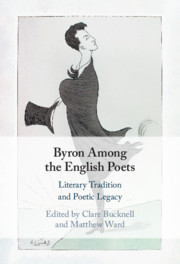Book contents
- Byron Among the English Poets
- Byron Among the English Poets
- Copyright page
- Dedication
- Contents
- Contributors
- Acknowledgements
- Abbreviations
- Introduction
- Part I Inheritances
- Part II Contemporaries
- Part III Afterlives
- Chapter 14 In-Between Byrons: Byronic Legacies in Women’s Poetry of the Late Romantic to Mid-Victorian Era
- Chapter 15 Byron and Browning: Something and Nothing
- Chapter 16 Arnold’s Ambivalence and Byron’s Force and Fire
- Chapter 17 A. C. Swinburne and Byron’s Bad Ear
- Chapter 18 What Auden Made of Byron
- Chapter 19 Byronic Inflections in British Poetry since 1945
- Chapter 20 Byron Among Our Contemporaries
- Index
Chapter 18 - What Auden Made of Byron
from Part III - Afterlives
Published online by Cambridge University Press: 22 July 2021
- Byron Among the English Poets
- Byron Among the English Poets
- Copyright page
- Dedication
- Contents
- Contributors
- Acknowledgements
- Abbreviations
- Introduction
- Part I Inheritances
- Part II Contemporaries
- Part III Afterlives
- Chapter 14 In-Between Byrons: Byronic Legacies in Women’s Poetry of the Late Romantic to Mid-Victorian Era
- Chapter 15 Byron and Browning: Something and Nothing
- Chapter 16 Arnold’s Ambivalence and Byron’s Force and Fire
- Chapter 17 A. C. Swinburne and Byron’s Bad Ear
- Chapter 18 What Auden Made of Byron
- Chapter 19 Byronic Inflections in British Poetry since 1945
- Chapter 20 Byron Among Our Contemporaries
- Index
Summary
The idea that Auden should write a travel book occurred to him in the spring of 1936 after he had had lunch at Bryanston with Michael Yates, a former pupil from his days as a master at the Downs School. Yates reported that he was due to visit Iceland that summer as part of a small school trip, and, as he later recalled, Auden quickly became excited by the thought of the journey.1 His imagination had been stirred by thoughts of the North ever since his father had read the small boy Norse myths as bedtime stories. After some slightly tangled negotiations, Auden persuaded his publisher Faber to cover the costs of a trip, and he arranged with the teacher leading the excursion that they should meet while there: their experiences could form an element in the book that he had agreed to co-write with his friend Louis MacNeice. Auden took the boat from Hull sometime in mid-June, but as it happened MacNeice’s arrival was delayed until 9 August and the Bryanston party wasn’t scheduled to turn up till the 17, so Auden spent much of the time on his own, including the voyage out which took five or so tiresome days. He was not much taken with Reykjavik once disembarked: ‘Lutheran, drab and remote’ was his first impression.2 He spent a lonely week, with ‘nothing to do but soak in the only hotel with a licence; at ruinous expense’, not greatly diverted by the task of correcting the proofs of his next volume of poems which Faber had sent through. But then he set out to explore the island with a guide, taking an anthropological interest in local phenomena such as cheese making and herring gutting, and his spirits rose (Prose, I. 256, 258).
- Type
- Chapter
- Information
- Byron Among the English PoetsLiterary Tradition and Poetic Legacy, pp. 303 - 316Publisher: Cambridge University PressPrint publication year: 2021



